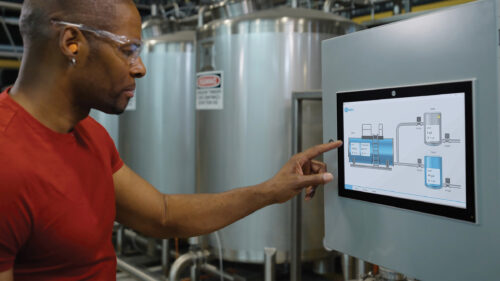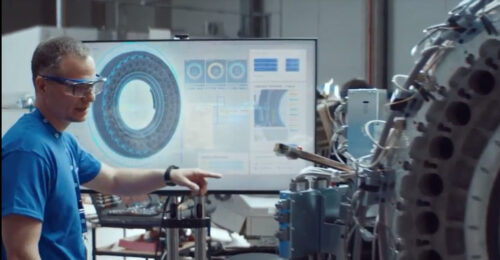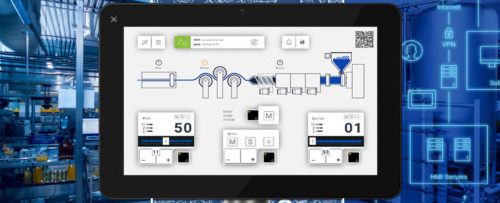Understanding applications, uses key to solenoid valve selection
Recent advancements in solenoid valve technology have expanded their scope of applications, while improving performance and reducing costs. To select the right valve for a given task, users should understand valve characteristics, consider critical factors, and be aware of some common problems and solutions in solenoid valve selection and maintenance.
Recent advancements in solenoid valve technology have expanded their scope of applications, while improving performance and reducing costs. To select the right valve for a given task, users should understand valve characteristics, consider critical factors, and be aware of some common problems and solutions in solenoid valve selection and maintenance.
A solenoid valve is an electro-mechanical device which, when energized or de-energized, either opens or closes a valve orifice. It’s designed to control the flow of air, water, oil, gas, steam — practically any liquid or gaseous substance.
Valve selection starts by considering which operating type best suits your application’s needs. Direct-acting valves open or close orifices by direct action of the core; pilot-operated valves for larger lines or higher pressures supplement this direct action by utilizing line pressure to open larger orifices while keeping solenoid size small. Normally closed valves open when energized and close when de-energized; normally open valves reverse this action.
Two-way solenoid valves have one inlet and one outlet pipe connection and are available normally open or closed. Three-way valves have three connections and two orifices and are available as normally open, normally closed, or universal (can be employed as either normally open or normally closed). Common applications include alternately applying pressure to and exhausting pressure from control valves, single-action cylinders, or actuators. Four-way valves use four or five pipe connections (one pressure, two cylinder, one or two exhausts) to operate double-acting cylinders or actuators.
Common applications and issues
The solenoid valve is the most efficient means of automatic flow control for many liquids and gases. It requires the least plumbing, wiring, expense, and effort. By contrast, many ball valve installations, for instance, require not just a ball assembly but an actuator and a solenoid valve.
Users must consider the basic factors of valve type, electrical operation, flow medium, valve size, line pressure, ambient atmosphere, operating temperatures, required voltage, and options such as special solenoid enclosures. Some of the most common issue that arise:
Over-rating pressure. A higher pressure rating does not mean a better valve. In fact, you should specify a valve whose specification most closely match the operating conditions of the specific application.
Not only may any higher rating waste money; it can actually impair valve operation, due to insufficient pressure drop (see below) or other problems.
Two-way, not bidirectional . Two-way valves are suitable for flow in one direction only. Install them to handle flow only in the direction indicated by the manufacturer; otherwise, operation may be unreliable or impossible.
Contaminated media . Contamination of line media is among the most common causes of solenoid valve problems. Most valves are designed for use with clean media; consult manufacturer’s recommendations for any exceptions.
If possible, install valves with their solenoids in a vertical position to prevent accumulation of foreign matter in core tubes. If there’s a chance of contamination, install a filter or strainer upstream of the valve inlet and make routine maintenance, based on the actual application and service history, a priority.
Undervoltage/overvoltage . Solenoid valves are generally designed to work at a nominal voltage plus or minus 10%.
If your power supply is inadequate, undervoltage may cause failure of the valve to open or close, excessive noise, chattering and reduced life. (Check for adequate voltage by energizing the coil and listening for the click as the core contacts the plugnut.) Overvoltage will cause overheating, premature solenoid failure and reduced life.
Incorrect capacity . Oversizing a valve results in unnecessary expense, and both oversizing and undersizing can result in substandard performance. Factors such as orifice size and valve configuration are combined into the flow coefficient, or Cv. Calculate the Cv required for your application, or consult the valve manufacturer.
Improper replacement in OEM equipment . Many solenoid valves in OEM products are constructed for specific media and service. Unsuitable replacements can bring reduced valve life, damage to the equipment, or even personal injury. Always consult the OEM’s maintenance instructions, or contact the technical support group of the valve manufacturer with application details.
Insufficient pressure drop . Another common problem arises because many solenoid valves rely on a pressure drop between inlet and outlet (or between inlet and exhaust in the case of three-way and four-way valves) for valve opening or closing. Below the specified minimum operating pressure differential, the valve may function erratically, or not at all.
When specifying a valve, always make sure it can operate with the minimum (and maximum) pressure differential it will see in service. Pay special attention to restrictions in your system such as speed controls or regulators, which may reduce pressure below this critical differential.
Wrong choice of electrical operation . Consider whether your application requires a specific electrical option. Basic solenoid valves provide simple on/off electrical control. Manual reset models add a manual capability for emergency use. Intrinsically safe valves use extremely low power to avoid sparks in explosive atmospheres.
Unsuitable materials of construction . Be sure to select a valve with materials of construction suitable for your application. For steam, hot water, potable water, corrosives, or cryogenic liquids, make sure your valve has the appropriate rating. For example, don’t employ an air valve to control fuel where a combustion valve is required.
Special valves for difficult applications are available with stainless steel or plastic bodies and a variety of trim materials, including nitrile rubber, neoprene, ethylene propylene, FKM, or PTFE.
Atmosphere issues . Solenoid valves for hazardous or explosive atmospheres employ features designed to prevent sparks or unacceptably high solenoid temperatures. These include special solenoid enclosures, thermal fuses, low power solenoids or air operators in place of solenoids.
Power availability issues . Solenoid valves are available for almost any ac or dc power supply. Be sure the valve selected is suitable for the power source available. Note that because of differences in internal construction, ac valves cannot be converted to dc nor dc to ac by changing the coil only.
New developments
As one of industry’s most ubiquitous instruments, the solenoid valve is being applied to new uses every day.
Specialty offshore pilot valves that draw power from solar panels are used in offshore oil platforms. Others models being introduced in process plants offer bus communications via DeviceNet, Profibus, and Foundation Fieldbus for fully networkable control.
One recent design defines a new category, the voltage-ranging solenoid valve. It draws ultra-low power (only 2 watts) and incorporates integrated electronics. This allows for dc pressure ratings at a level formerly only available with traditional ac valves.
Another long-wearing design is increasingly popular among users to provide very high flow rates, and handle corrosive or contaminated media, light slurries, steam, or other difficult media. These auxiliary-piloted, angle-body piston valves are ideal where media would not be suitable for the internal workings of a traditional solenoid valve. These rigorous applications can be found anywhere from commercial laundries to industrial process plants.
Solenoid control valve troubleshooting guide
Problem
Possible Cause
Possible Solution
Valve will not operate when valve circuit is energized (direct-acting valve)
Low voltage or no voltage to solenoid coil
Check voltage at coil; voltage should be at least 85 percent of nameplate rating.
Burned out coil
See “Coil Failure” below.
Foreign matter jamming core in core tube
Clean valve; install strainer close to valve inlet.
Binding core or damaged core tube
Replace parts.
Excessive fluid pressure
Reduce pressure to valve nameplate pressure rating or install suitable valve.
Valve will not operate when valve circuit is energized (pilot-operated valve)
Same causes and solutions as for direct-acting valve, plus:
Low pressure drop across valve
Valve might be oversized; replace valve with one having a smaller orifice. Increase pressure, one having a smaller orifice. Increase pressure, if possible.
Ruptured diaphragm or piston ring
Replace damaged parts.
Plugged or restricted pilot orifice
Clean valve and pilot orifice.
Valve will not close or shift when valve circuit is de-energized (direct-acting valve)
Coil not de-energized
Check electrical control circuit.
Foreign matter jamming core in core tube
Clean valve; install strainer close to valve inlet.
Damaged disc or seat causing internal leakage
Replace with new parts.
Binding core or damaged core tube
Replace with new parts.
Damaged spring
Replace with new spring. Never elongate or shorten spring.
Valve will not close or shift when valve circuit is de-energized (pilot-operated valve)
Same causes and solutions as for direct-acting valve, plus:
Plugged bleed orifice
Clean orifice.
Damaged pilot seat or pilot disc
Replace with new parts.
Damaged diaphragm or piston
Replace with new parts.
Insufficient pressure drop across the valve
Valve might be oversized; replace valve with one having a smaller orifice. Increase pressure, if possible.
Dirt or foreign matter is lodged on seat
Replace valve body or install new valve; install suitable strainer close to inlet of valve.
Coil failure
Overvoltage
Check voltage at coil; voltage must conform to nameplate rating.
Damaged core or core tube causing inrush current to be drawn continuously
Check for damaged core and core tube, or damaged spring. Check for scale or foreign matter on the core or inside the core tube.
Foreign matter jamming core in core tube and causing inrush current to be drawn continuously
Clean thoroughly and replace any damaged parts.
Excessive fluid pressure causing inrush current to be drawn continuously
Reduce pressure or install suitable valve.
Excessive ambient or fluid temperature
Class A coils are limited to ambient temperatures of 77 F. For temperatures up to 167 F, use Class F coils; for temperatures up to 212 F, use Class H.
Missing solenoid parts
Install missing solenoid housing and other metal parts or properly install incorrectly assembled metal parts. The housing and other metal parts form part of the magnetic circuit and are required to provide the impedance needed to limit current draw.
Moisture inside solenoid enclosure
Waterproof the entrance conduit to prevent entry of moisture. If valve is mounted outdoors, check to see that enclosure is weatherproof and that gaskets are in good condition; use appropriate sealant when required. If general-purpose enclosure is used in a damp or humid atmosphere, use watertight, molded coils.
Author Information
David Zdobinski is senior engineering manager, William Mudd is manager of technical services and Gregory Byrne is service manager for ASCO Valve, Inc., Florham Park, NJ.
The Bottom Line…
Avoid common misapplication errors for more reliable performance and longer valve life
Don’t get more — or less — of a valve than your application needs
New models allow handling of more varied and aggressive fluids, lower power usage, networkability, and more.
NIST gears up to evaluate short-range 3D imaging
Three-dimensional imaging devices are becoming important measuring tools in the manufacturing, construction and transportation sectors. Numerous models, capable of digitally capturing the existing conditions of objects from as small as pipe fittings to as large as bridges, are on the market. But a lack of standard tests to verify manufacturers’ performance specifications is inhibiting wider acceptance of these devices.
In response, researchers at the National Institute of Standards and Technology (NIST) recently established an indoor, artifact-based facility to create new test protocols and performance measurements to evaluate such 3D imaging systems. Several prototype artifacts are currently being tested for evaluating both instruments and software.
The new facility is part of a larger effort to provide standard test protocols and associated facilities for evaluating and calibrating these instruments. In addition to the indoor, artifact-based facility, NIST also operates an indoor, 60-meter range calibration facility and is developing a separate 3D facility so that manufacturers or research groups can send in instruments for spatial calibrations. NIST will also establish an outdoor ranging facility for evaluating the performance of 3D imaging systems up to 150 to 200 meters.
A consensus-based standards development process will begin this summer.
Protocols for evaluating the range performance of imaging devices and a draft list of commonly used terminology will be submitted to ASTM International, a standards-development organization. These standards will provide comparisons of different 3D imaging devices, reduce confusion about terminology and increase user confidence in the systems, said Alan Lytle, leader of the NIST Construction Metrology and Automation Group.
HVAC/R professionals say energy efficiency, building automation are key industry issues
According to an online survey conducted at the AHR Expo, HVAC/R professionals are most interested in learning more about improving energy efficiency, building automation, and Green Building technology. More than 800 responses from 2006 show attendees were analyzed to gauge the pulse of the industry.
Respondents said the most important issues included energy efficiency, savings and recovery, building controls, automation and integration, Green Building issues and technology, indoor air quality and solar and other alternative energy sources.
In response to industry feedback, AHR Expo has introduced several new show features and enhancements for 2007. They include a variety of association-sponsored educational sessions focusing on energy-efficiency and building automation topics, in addition to the ASHRAE conference program and short courses; a special focus on Green Buildings featuring “green” exhibitors and new conference sessions by the United States Green Building Council; the New Product Technology Theater, where leading companies will present brief previews of their latest technologies and products, including many dealing with energy efficiency, building automation and Green Buildings, and an expanded Building Automation & Control Showcase area on the show floor.
Do you have experience and expertise with the topics mentioned in this content? You should consider contributing to our CFE Media editorial team and getting the recognition you and your company deserve. Click here to start this process.





